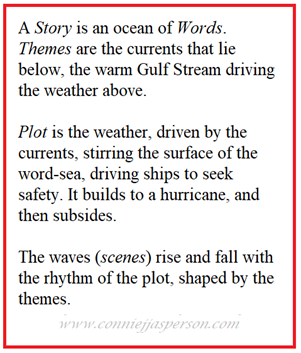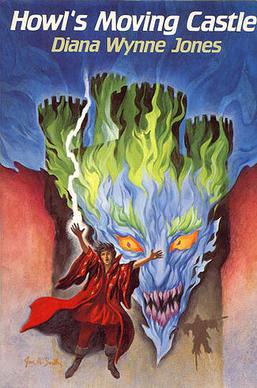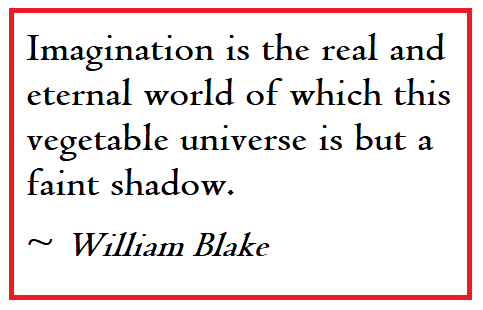Chapter breaks are transitions. I have found that chapter breaks fall naturally at certain places as I write. I’ve discussed this before, but I’m always happy to repeat myself. In my opinion, chapters can be the length they need to be.
 When we commit to writing daily, our writing style grows and changes. When I began writing, some chapters totaled over 4,000 words.
When we commit to writing daily, our writing style grows and changes. When I began writing, some chapters totaled over 4,000 words.
As my writing style evolved, chapters became shorter. Now they average between 1,500 to 2,250. Some will be much shorter and some might be longer if the story demands it.
I try to consider the comfort of my reader. Many readers are like me—they want to finish a chapter in one sitting. Several years ago, I attended a seminar by a well-known author who said he has a specific word-count limit for chapter length.
I’ve read and enjoyed many books where the authors made each scene a chapter, even if it was only two or three hundred words long. They ended up with over 100 chapters in their books, but the chapter length went unnoticed by me when I read it. L.E. Modesitt Jr. sometimes has chapters of only five or six hundred words, which keeps each point-of-view character’s storyline separate and flows well.
So, chapter length is a personal choice. But it does affect how the pacing of the overall story is perceived by the reader.
 As a reader, books work best for me when each chapter details the events of one large scene or several related events. I think of chapters as if they were paragraphs. Paragraphs are not just short blocks of randomly assembled sentences.
As a reader, books work best for me when each chapter details the events of one large scene or several related events. I think of chapters as if they were paragraphs. Paragraphs are not just short blocks of randomly assembled sentences.
- A paragraph is a group of sentences that fleshes out a single idea.
- That means that only one thought or speaker is featured in each paragraph.
Chapters are hard breaks. They are like paragraphs and can affect the overall pacing of the narrative. Packing too many unrelated ideas into one place makes them feel erratic and disconnected and throws off the pacing. It’s only my opinion, and in the end, you must decide what your style is going to be.
The way an author handles transitions is the key to a smooth, seamless narrative. As discussed in my previous post, a transition is a connecting scene moving the story forward to the following incident.
Conversely, the transition can be a scene that opens or closes a chapter by offering a tidbit of information that compels the reader to turn the page—the hook:
Conversations should detail something one or more characters don’t know. A conversation is an opportunity to close a scene or chapter with a hook.
Fade-to-black: I’m not too fond of fade-to-black transitions except as a finish to a chapter. Fading-to-black in the middle of a chapter makes the story feel mushy.
Hard scene breaks: Sometimes, we must indicate that a space of time has passed with nothing happening that’s important or worth wasting words on. When a length of time has passed between the end of one scene and the beginning of the next, it makes sense to use the old 1-2-3:
- Wind the scene up with a firm finish.
- Leave the reader with a hook that makes them want to turn the page.
- Start a new chapter.
Sometimes an event occurs where more than one character has a point of view that needs to be shown. How you navigate this will significantly affect the readability of the narrative.
Most readers find it easier to follow the story when they are only in one character’s mind for the majority of the narrative.
If you switch POV characters, I strongly suggest changing scenes with a hard, visual break such as a blank space between paragraphs or ending the chapter.
Some editors suggest you change chapters, no matter how short when you switch to a different character’s point of view. That is my choice also, as a hard transition between characters is the best way to avoid head-hopping.
Head-hopping: first, you’re in his head, then you’re in hers, then you’re back in his—it gives the reader “tennis neck” and makes following the storyline difficult.
 I’ve mentioned before that one of the complaints some readers have with Robert Jordan’s brilliant Wheel of Time Series is how he wandered around between storylines as if he couldn’t decide who the main character was.
I’ve mentioned before that one of the complaints some readers have with Robert Jordan’s brilliant Wheel of Time Series is how he wandered around between storylines as if he couldn’t decide who the main character was.
Then there is Howl’s Moving Castle, by Diana Wynne Jones. She consistently wrote two points of view into one paragraph. The story and characters are brilliant, but that habit made the dialogue difficult to follow in some places.
I don’t write at the level of Robert Jordan’s or Diana Wynne Jones’s prose and storytelling, so I try to focus on one storyline per scene and not head hop.
Now we come to a commonly asked question: Should I use numbers or give each chapter a name?
There is no rule—only authorial preference.
What is your gut feeling about how you want to construct this book or series? If good titles pop up in your mind for each chapter, by all means, go for it. Otherwise, numbered chapters are perfectly fine and don’t throw the reader out of the book.
Whether you choose numbered or titled chapter headings, be consistent and stay with that choice for the entire book.
To sum things up:
- Limit point of view characters to one per scene.
- Each chapter should detail related scenes and events rather than a jumble of unrelated happenings.
- In regard to chapter length, you, as the author, must decide what the right word count is.
- End your chapters at a logical place, but doend each chapter with a hook that begs the reader to continue on to the next chapter.
One final thing – Some literary contests and publications have a “novella,” a “novelette,” and a “short story” category. The length for these categories is based on word count.
 Short stories run up to 7,000 words, with under 4,000 being the most commonly requested length. 7,500–17,500 is the expected length for novelettes, and between 17,500 and 40,000 words are the standard length for novellas.
Short stories run up to 7,000 words, with under 4,000 being the most commonly requested length. 7,500–17,500 is the expected length for novelettes, and between 17,500 and 40,000 words are the standard length for novellas.
Short stories are constructed like novels but with one difference. If you are writing a short story, dividing it into chapters isn’t an option, but you may feel that a hard break is required at the end of a scene. In that case, editors with open calls for short stories will often ask that you insert an asterisk or hashtag to indicate a hard scene break.
Longer novelettes might have chapters. Novellas will probably be broken into chapters. The piece’s length determines whether or not hard chapter breaks are useful.
We each have an idea of how we want our finished work to look. We know what works for us as readers. Go with your gut, and chances are you will do fine.








Reblogged this on Kim's Musings.
LikeLiked by 1 person
Kim, thank you for the reblog! ❤
LikeLiked by 1 person